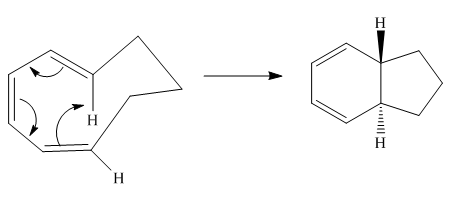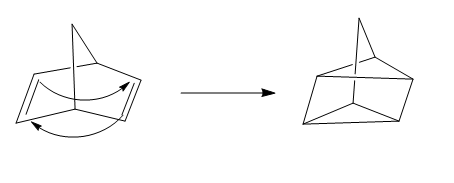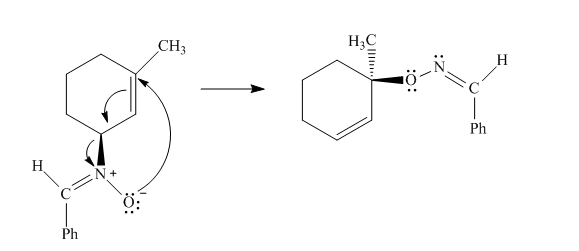
Concept explainers
(a)
Interpretation:
The curved arrow mechanism for the reaction is to be stated and the reaction is to be classified as electrocyclic, cycloaddition, and the sigmatropic reaction. Along with that the number of electrons involved in the reaction is to be stated.
Concept introduction:
In the pericyclic reactions, the bond formation and dissociation occur simultaneously. The pericyclic reaction occurs in a concerted fashion with the cyclic shift of electrons. They are of three types, electrocyclic, cycloaddition and the sigmatropic reactions. They occur in the presence of heat or light.
Answer to Problem 28.1P
The given reaction is an example of an electrocyclic pericyclic reaction. The number of electrons involved in this reaction is six. The curved arrow mechanism is shown below.

Explanation of Solution
The given reaction is an example of an electrocyclic reaction. This is because of in this electrocyclic reaction there is an intramolecular

Figure 1
The curved arrow mechanism for the reaction is shown in Figure 1. The reaction is a type of electrocyclic reaction. Along with it, the number of electrons involved in this reaction is six.
(b)
Interpretation:
The curved arrow mechanism for the reaction is to be stated and the reaction is to be classified as electrocyclic, cycloaddition, and the sigmatropic reaction. Along with that the number of electrons involved in the reaction is to be stated.
Concept introduction:
In the pericyclic reactions, the bond formation and dissociation occur simultaneously. The pericyclic reaction occurs in a concerted fashion with the cyclic shift of electrons. They are of three types electrocyclic, cycloaddition and the sigmatropic reactions. They occur in the presence of heat or light.
Answer to Problem 28.1P
The given reaction is an example of a sigmatropic pericyclic reaction. The number of electrons involved in this reaction is two. The curved arrow mechanism is shown below.

Explanation of Solution
The given reaction is an example of a sigmatropic reaction. This is because of in this sigmatropic reaction the allylic sigma bond present at one end of the system migrate to the other end of the system. The number of

Figure 2
The curved arrow mechanism for the reaction is shown in Figure 2. The reaction is a type of sigmatropic reaction. Along with it, the number of electrons involved in this reaction is two.
(c)
Interpretation:
The curved arrow mechanism for the reaction is to be stated and the reaction is to be classified as electrocyclic, cycloaddition, and the sigmatropic reaction. Along with that the number of electrons involved in the reaction is to be stated.
Concept introduction:
In the pericyclic reactions, the bond formation and dissociation occur simultaneously. The pericyclic reaction occurs in a concerted fashion with the cyclic shift of electrons. They are of three types electrocyclic, cycloaddition and the sigmatropic reactions. They occur in the presence of heat or light.
Answer to Problem 28.1P
The given reaction is an example of a cycloaddition pericyclic reaction. The number of electrons involved in this reaction is four. The curved arrow mechanism is shown below.

Explanation of Solution
The given reaction is an example of a cycloaddition reaction. This is because of in this cycloaddition reaction two

Figure 3
The curved arrow mechanism for the reaction is shown in Figure 3. The reaction is a type of cycloaddition reaction. Along with it, the number of electrons involved in this reaction is four.
(d)
Interpretation:
The curved arrow mechanism for the reaction is to be stated and the reaction is to be classified as electrocyclic, cycloaddition, and the sigmatropic reaction. Along with that the number of electrons involved in the reaction is to be stated.
Concept introduction:
In the pericyclic reactions, the bond formation and dissociation occur simultaneously. The pericyclic reaction occurs in a concerted fashion with the cyclic shift of electrons. They are of three types electrocyclic, cycloaddition and the sigmatropic reactions. They occur in the presence of heat or light.
Answer to Problem 28.1P
The given reaction is an example of a sigmatropic pericyclic reaction. The number of electrons involved in this reaction is six. The curved arrow mechanism is shown below.

Explanation of Solution
The given reaction is an example of a sigmatropic reaction. This is because of in this sigmatropic reaction the allylic sigma bond present at one end of the

Figure 4
The curved arrow mechanism for the reaction is shown in Figure 4. The reaction is a type of sigmatropic reaction. Along with it, the number of electrons involved in this reaction is six.
(e)
Interpretation:
The curved arrow mechanism for the reaction is to be stated and the reaction is to be classified as electrocyclic, cycloaddition, and the sigmatropic reaction. Along with that the number of electrons involved in the reaction is to be stated.
Concept introduction:
In the pericyclic reactions, the bond formation and dissociation occur simultaneously. The pericyclic reaction occurs in a concerted fashion with the cyclic shift of electrons. They are of three types electrocyclic, cycloaddition and the sigmatropic reactions. They occur in the presence of heat or light.
Answer to Problem 28.1P
The given reaction is an example of a retro-electrocyclic pericyclic reaction. The number of electrons involved in this reaction is two. The curved arrow mechanism is shown below.

Explanation of Solution
The given reaction is an example of a retro-electrocyclic reaction. This is because of in the electrocyclic reaction there is an intramolecular

Figure 5
The curved arrow mechanism for the reaction is shown in Figure 5. The reaction is a type of retro-electrocyclic reaction. Along with it, the number of electrons involved in this reaction is two.
Want to see more full solutions like this?
Chapter 28 Solutions
Organic Chemistry, Ebook And Single-course Homework Access
- Hi, I need your help with the drawing, please. I have attached the question along with my lab instructions. Please use the reaction from the lab only, as we are not allowed to use outside sources. Thank you!arrow_forwardHi, I need your help i dont know which one to draw please. I’ve attached the question along with my lab instructions. Please use the reaction from the lab only, as we are not allowed to use outside sources. Thank you!arrow_forward5. Write the formation reaction of the following complex compounds from the following reactants: 6. AgNO₃ + K₂CrO₂ + NH₄OH → 7. HgNO₃ + excess KI → 8. Al(NO₃)₃ + excess NaOH →arrow_forward
- Indicate whether the product formed in the reaction exhibits tautomerism. If so, draw the structure of the tautomers. CO₂C2H5 + CH3-NH-NH,arrow_forwardDraw the major product of this reaction N-(cyclohex-1-en-1-yl)-1-(pyrrolidino) reacts with CH2=CHCHO, heat, H3O+arrow_forwardDraw the starting material that would be needed to make this product through an intramolecular Dieckmann reactionarrow_forward
- Draw the major product of this reaction. Nitropropane reacts + pent-3-en-2-one reacts with NaOCH2CH3, CH3CHOHarrow_forwardIndicate whether the product formed in the reaction exhibits tautomerism. If so, draw the structure of the tautomers. OC2H5 + CoHs-NH-NH,arrow_forwardExplain how substitutions at the 5-position of barbituric acid increase the compound's lipophilicity.arrow_forward
- Explain how substitutions at the 5-position of phenobarbital increase the compound's lipophilicity.arrow_forwardName an interesting derivative of barbituric acid, describing its structure.arrow_forwardBriefly describe the synthesis mechanism of barbituric acid from the condensation of urea with a β-diketone.arrow_forward
 ChemistryChemistryISBN:9781305957404Author:Steven S. Zumdahl, Susan A. Zumdahl, Donald J. DeCostePublisher:Cengage Learning
ChemistryChemistryISBN:9781305957404Author:Steven S. Zumdahl, Susan A. Zumdahl, Donald J. DeCostePublisher:Cengage Learning ChemistryChemistryISBN:9781259911156Author:Raymond Chang Dr., Jason Overby ProfessorPublisher:McGraw-Hill Education
ChemistryChemistryISBN:9781259911156Author:Raymond Chang Dr., Jason Overby ProfessorPublisher:McGraw-Hill Education Principles of Instrumental AnalysisChemistryISBN:9781305577213Author:Douglas A. Skoog, F. James Holler, Stanley R. CrouchPublisher:Cengage Learning
Principles of Instrumental AnalysisChemistryISBN:9781305577213Author:Douglas A. Skoog, F. James Holler, Stanley R. CrouchPublisher:Cengage Learning Organic ChemistryChemistryISBN:9780078021558Author:Janice Gorzynski Smith Dr.Publisher:McGraw-Hill Education
Organic ChemistryChemistryISBN:9780078021558Author:Janice Gorzynski Smith Dr.Publisher:McGraw-Hill Education Chemistry: Principles and ReactionsChemistryISBN:9781305079373Author:William L. Masterton, Cecile N. HurleyPublisher:Cengage Learning
Chemistry: Principles and ReactionsChemistryISBN:9781305079373Author:William L. Masterton, Cecile N. HurleyPublisher:Cengage Learning Elementary Principles of Chemical Processes, Bind...ChemistryISBN:9781118431221Author:Richard M. Felder, Ronald W. Rousseau, Lisa G. BullardPublisher:WILEY
Elementary Principles of Chemical Processes, Bind...ChemistryISBN:9781118431221Author:Richard M. Felder, Ronald W. Rousseau, Lisa G. BullardPublisher:WILEY





